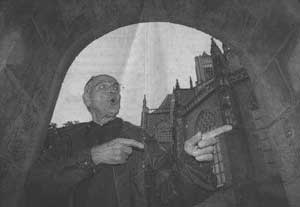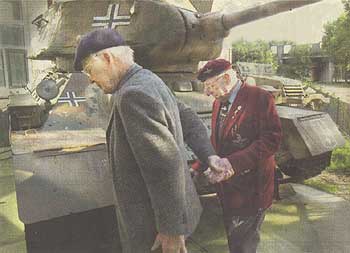Name: Horst Weber
Rank: Kompagnie-Trupp-Fuhrer
Unit: 1ste Bat.
Regiment: 21st Regiment Frundsberg Division
 I was Kompagnie-Trupp-Fuhrer in the Frundsberg Division and arrived at Arnhem in the afternoon of September 17th at Musis
Sacrum. I was in a group of about 150 young men of 17 or 18 years old and we hardly knew each
other. We were rounded up at Diepenveen and formed the new 1st battalion of the 21st
regiment.
I was Kompagnie-Trupp-Fuhrer in the Frundsberg Division and arrived at Arnhem in the afternoon of September 17th at Musis
Sacrum. I was in a group of about 150 young men of 17 or 18 years old and we hardly knew each
other. We were rounded up at Diepenveen and formed the new 1st battalion of the 21st
regiment.
Our orders were: to force the enemy to surrender and occupy the bridge. Who should be in charge we would find out on our way. On the 17th we had no officers at all at the scene!
Along the houses on the 'Beekstraat', 'Koningstraat' and 'de singels' we advanced towards the bridge. The British in the center were completely surprised and we took some prisoners fairly easy. Once arriving at the 'Walburgisstraat' close to Town Hall we encountered fierce resistance. To send in soldiers would be suicidal, we used the word 'Himmelfahrtkommando' for such an attack.
Our group of aprox 150 soldiers were positioned on the west side of the bridge and another group of aprox 65 on the eastside. All together not more then 225 men that had to fight against aprox 900 British. We were wondering why they did not take positions further away from the bridge on 'the singels' to attack us on our approach. Because we had only 225 men we constantly had to move from one position to another to make it look like we had more men. On the 18th we managed to conquer a few houses which we set on fire.
We were cautious the first 2 days as we were expecting attacks from the Dutch resistance in our back. But to our advantage these attacks did not come.
 In the building what we now know as 'Duivelshuis' we found a large number of
British wounded. It was a horrifying scene and we could do nothing for them at that time
as we had no medical supplies of any kind and there was no water. The only thing I could
do was get a few apples from a grocery nearby and give these to them. The British doctor
Logan did all he could do but he was exhausted as he did not rest for two days and nights.
In the building what we now know as 'Duivelshuis' we found a large number of
British wounded. It was a horrifying scene and we could do nothing for them at that time
as we had no medical supplies of any kind and there was no water. The only thing I could
do was get a few apples from a grocery nearby and give these to them. The British doctor
Logan did all he could do but he was exhausted as he did not rest for two days and nights.
We never expected to be able to recapture the bridge. It was our artillery that beat the Para's in the end. Not long after the surrender of the remaining British forces at the bridge we marched to Elst. I later heard that the Bridge was bombed in October. Bombed by the Allied Air Force. The allies destroyed the Bridge that they had fought so hard over and defended with their own blood. The war continued for seven months and caused a lot of destruction and suffering to the Dutch civillians. We as German soldiers of that time can do nothing else then ask to be forgiven.
Colour photo: Horst Weber and Bill Fullton at the Arnhem War Museum.


















